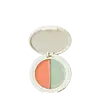What's inside
What's inside
 Key Ingredients
Key Ingredients

 Benefits
Benefits

 Concerns
Concerns

 Ingredients Side-by-side
Ingredients Side-by-side

Isononyl Isononanoate
EmollientOctyldodecanol
EmollientOctyldodecyl Stearoyl Stearate
EmollientKaolin
AbrasiveHydrogenated Castor Oil
EmollientSynthetic Wax
AbrasiveMica
Cosmetic ColorantSilica Dimethyl Silylate
EmollientSilica
AbrasiveTocopheryl Acetate
AntioxidantPhenethyl Alcohol
MaskingCaprylyl Glycol
EmollientSimmondsia Chinensis Seed Oil
EmollientLauroyl Lysine
Skin ConditioningCI 77891
Cosmetic ColorantCI 77492
Cosmetic ColorantCI 42090
Cosmetic ColorantCI 73360
Cosmetic ColorantIsononyl Isononanoate, Octyldodecanol, Octyldodecyl Stearoyl Stearate, Kaolin, Hydrogenated Castor Oil, Synthetic Wax, Mica, Silica Dimethyl Silylate, Silica, Tocopheryl Acetate, Phenethyl Alcohol, Caprylyl Glycol, Simmondsia Chinensis Seed Oil, Lauroyl Lysine, CI 77891, CI 77492, CI 42090, CI 73360
Petrolatum
EmollientOctyldodecyl Stearoyl Stearate
EmollientBis-Diglyceryl Polyacyladipate-2
EmollientMethyl Methacrylate Crosspolymer
Tribehenin
EmollientKaolin
AbrasiveSilica
AbrasivePolyethylene
AbrasiveTocopheryl Acetate
AntioxidantLecithin
EmollientPolysorbate 20
EmulsifyingTocopherol
AntioxidantPropylene Glycol Stearate
Skin ConditioningTetrahexyldecyl Ascorbate
AntioxidantMicrocrystalline Wax
Emulsion StabilisingSorbitan Laurate
EmulsifyingCaprylyl Glycol
EmollientPropylene Glycol Laurate
Skin ConditioningCI 77891
Cosmetic ColorantIron Oxides
CI 77007
Cosmetic ColorantMica
Cosmetic ColorantPetrolatum, Octyldodecyl Stearoyl Stearate, Bis-Diglyceryl Polyacyladipate-2, Methyl Methacrylate Crosspolymer, Tribehenin, Kaolin, Silica, Polyethylene, Tocopheryl Acetate, Lecithin, Polysorbate 20, Tocopherol, Propylene Glycol Stearate, Tetrahexyldecyl Ascorbate, Microcrystalline Wax, Sorbitan Laurate, Caprylyl Glycol, Propylene Glycol Laurate, CI 77891, Iron Oxides, CI 77007, Mica
Ingredients Explained
These ingredients are found in both products.
Ingredients higher up in an ingredient list are typically present in a larger amount.
Caprylyl Glycol is a humectant and emollient, meaning it attracts and preserves moisture.
It is a common ingredient in many products, especially those designed to hydrate skin. The primary benefits are retaining moisture, skin softening, and promoting a healthy skin barrier.
Though Caprylyl Glycol is an alcohol derived from fatty acids, it is not the kind that can dry out skin.
This ingredient is also used as a preservative to extend the life of products. It has slight antimicrobial properties.
Learn more about Caprylyl GlycolCi 77891 is a white pigment from Titanium dioxide. It is naturally found in minerals such as rutile and ilmenite.
It's main function is to add a white color to cosmetics. It can also be mixed with other colors to create different shades.
Ci 77891 is commonly found in sunscreens due to its ability to block UV rays.
Learn more about CI 77891Kaolin is a clay. It is used for oil control and to help minimize pores. Like other clays, kaolin has the ability to absorb excess sebum or oil. This can help clean out pores and mattify the skin.
Some types of kaolin may have exfoliating properties. When water is added to kaolin, it becomes a paste with small abrasive particles.
Most kaolin is a white color, but may be pink/orange/red depending on where it comes from.
The name 'kaolin' comes from a Chinese village named 'Gaoling'. Kaolin clay comes from rocks rich in kaolinite. Kaolinite, the mineral, has a silicate layered structure. Kaolinite is formed from chemical weathering of aluminum siilicate minerals.
Besides skincare, kaolin is commonly used to make glossy paper, in ceramics, toothpaste, and as medicine to soothe stomach issues.
Learn more about KaolinMica is a naturally occurring mineral used to add shimmer and color in cosmetics. It can also help improve the texture of a product or give it an opaque, white/silver color.
Serecite is the name for very fine but ragged grains of mica.
This ingredient is often coated with metal oxides like titanium dioxide. Trace amounts of heavy metals may be found in mica, but these metals are not harmful in our personal products.
Mica has been used since prehistoric times throughout the world. Ancient Egyptian, Indian, Greek, Roman, Aztec, and Chinese civilizations have used mica.
Learn more about MicaOctyldodecyl Stearoyl Stearate is created from stearic acid.
It is an emollient and thickens the lipid (oil) portion of a product. Due to its emollient properties, it may not be fungal-acne safe.
Silica, also known as silicon dioxide, is a naturally occurring mineral. It is used as a fine, spherical, and porous powder in cosmetics.
Though it has exfoliant properties, the function of silica varies depending on the product.
The unique structure of silica enhances the spreadability and adds smoothness, making it a great texture enhancer.
It is also used as an active carrier, emulsifier, and mattifier due to its ability to absorb excess oil.
In some products, tiny microneedles called spicules are made from silica or hydrolyzed sponge. When you rub them in, they lightly polish away dead skin layers and enhance the penetration of active ingredients.
Learn more about SilicaTocopheryl Acetate is AKA Vitamin E. It is an antioxidant and protects your skin from free radicals. Free radicals damage the skin by breaking down collagen.
One study found using Tocopheryl Acetate with Vitamin C decreased the number of sunburned cells.
Tocopheryl Acetate is commonly found in both skincare and dietary supplements.
Learn more about Tocopheryl Acetate